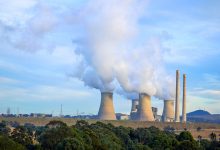Government-commissioned modelling has shown that attempting to extend the life of the Liddell power station – long the favoured option of many in the Coalition government – ranks as one of the worst options for maintaining reliable supplies of power in New South Wales.
The modelling, which was quietly published by the Morrison government on Tuesday, shows that better outcomes could be achieved by investing in new energy storage projects, and that wind and solar could provide lower-cost supplies of power.
The Coalition government has threatened to intervene to prevent the closure of the Liddell power station, either by acquiring the power station or paying for an extension to its operating life. But the government commissioned modelling shows that this was not the best approach to ensuring cheap and reliable power for New South Wales.
After withholding their release following publication of the report of the Liddell Taskforce, the Department of Industry, Science, Energy and Resources published two sets of modelling, detailing the predicted impacts of the closure of the Liddell power station, and assessing the different options available to replace the ageing power station with new projects.
It is understood the Morrison government published the modelling after being told the Australian Greens would seek a parliamentary order for their release through the federal senate.
The modelling, completed late last year by Frontier Economics and the Australian Energy Market Operator, found an extension to the life of the Liddell power station ranked amongst one of the worst options, compared to alternatives that included the construction of new pumped hydro energy storage projects.
AEMO found that the continued operation of the Liddell power station would underperform across many of the key criteria assessed, including the ability to deliver flexible power supplies. An extension of the Liddell power station was also accessed as having unacceptably high rates of forced outages, reflecting the diminishing reliability of a power station that is almost 50 years old.
“Liddell’s current operations and its life extension option were found to fall short of some 2025 system needs and represents one of the lowest ranked replacement options,” the AEMO report says.
“The minimal expected 2025 system need generally requires more flexible and responsive generation and less dispatchable capacity than Liddell’s current operations, as a result of additional generation and interconnection already coming online.”
The Morrison government has threatened to intervene in the energy market by constructing a new 250MW gas-fired generator in New South Wales, initially suggesting that it would build a gas plant as large as 1,000MW in capacity, arguing that a new power station of that kind would be necessary to provide a like-for-like replacement of the Liddell power station.
However, the AEMO modelling found that the construction of a new open cycle gas turbine would also underperform as a potential replacement for Liddell, scoring only slightly better than a Liddell extension.
AEMO also predicated its modelling on needing just 215MW of new generation capacity to bridge any gap left by Liddell’s closure, a figure that has been further revised downwards, to just 154MW in the most recent Electricity Statement of Opportunities, published by the marker operator.
Australian Greens leader Adam Bandt says the modelling showed the Morrison government’s push to construct a new gas-fired generator was not justified by the advice being given to the government.
“Never trust anything Angus Taylor says about numbers,” Bandt said. “AEMO’s modelling confirms that Minister Taylor’s 1,000 MW dispatchable energy gap is a fiction, a fiction designed to prop up public funding for more dirty gas capacity to please his big fossil donors.”
“With the Liddell Taskforce Report and more recent Reputex modelling both showing no need for a publicly funded gas-fired power station, it’s time for Angus Taylor to dump his white elephant of a project and get behind a 100% renewable energy future.”
AEMO’s assessment found that there may already be sufficient investment underway in the energy market to fill any gap left by Liddell’s closure, finding that a combination of the Snowy 2.0 expansion and the establishment of the HumeLink interconnector between New South Wales and Victoria, would satisfy the requirements for a like-for-like replacement of Liddell power station.
However, AEMO noted that it was unlikely that both Snowy 2.0 and HumeLink would be completed prior to the scheduled closure of the Liddell power station in 2023.
“Pumped storage scores highly in the 2025 system needs assessment but does not meet all needs, and any new pumped storage project is expected to be available in 2024 at the earliest, which is after the scheduled closure of Liddell in April 2023,” AEMO said.
AEMO’s assessment also found that the development of new wind and solar projects, combined with some form of firming capacity, would also be sufficient to fill a gap left by Liddell, and was a better option than attempting to extend the operating life of Liddell.
The Frontier economics modelling showed that it was likely that wholesale electricity prices in New South Wales would rise following the closure of the Liddell power station, but that this effect would also be short-lived, and much smaller than increases seen following the closure of the Hazelwood power station in Victoria.
Frontier found that electricity prices would stabilise as more wind and solar capacity entered the market, including new projects delivered as a result of the NSW government’s Emerging Energy Program.
Both pieces of modelling were undertaken prior to the announcement of the NSW government’s ambitious electricity infrastructure strategy, that has now been formally legislated, and is aiming to deliver as much as 12GW of new wind and solar projects, and 2GW of energy storage projects, by 2030.










